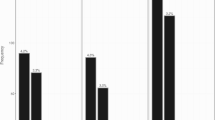Abstract
Objectives
To determine the frequency, location, and shape of distomolar teeth in a population of urban Turkish adults.
Methods
A total of 4,023 patients (1,586 males, 2,437 females) with a mean age of 32.85 ± 10.82 years (males 33.01 ± 11.39, females 32.76 ± 10.62) were studied. Patients younger than 18 years of age were excluded. Panoramic radiographs of the patients were examined to diagnose the presence of distomolar teeth. In the diagnosis, care was taken to include only those patients who had not undergone any extractions in the third molar regions. Data were analyzed by the chi-squared test (P < 0.05).
Results
The presence of distomolars was observed in 0.57% of this population. In total, 29 distomolar teeth were observed in 23 patients. Distomolars were found primarily in the maxillary left (n = 8, 27.5% of the distomolars) and right quadrants (n = 6, 20.6% of the distomolars). In one patient, they were observed in all four quadrants. Distomolars occured more frequently in the maxilla (n = 20, 68.9% of the distomolars), were often impacted (n = 20, 68.9% of the distomolars), and were found bilaterally in three cases (0.07%).
Conclusion
In cases of infection and pain in the molar area, dental practioners may be suspicious of the presence of fourth molars in fully erupted dentition and should make a detailed and careful investigation of panoramic radiographs.


Similar content being viewed by others
References
Kokten G, Balcioglu H, Buyukertan M. Supernumerary fourth and fifth molars: a report of two cases. J Contemp Dent Pract. 2003;4:67–76.
Nevilla BW, Damm DD, Allen CM, Bouyuot JE. Oral and maxillofacial pathology. 1st ed. Philadelphia: W.B. Saunders; 1995.
Ghom AG. Textbook of oral medicine. 2nd ed. New Delhi: Jaypee Brothers Medical Publishers; 2005.
Grimanis GA, Kyriakides AT, Spyropoulos ND. A survey on supernumerary molars. Quintessence Int. 1991;22:989–95.
Menardia-Pejuan V, Berini-Aytes L. Supernumerary molars. A review of 53 cases. Int Res Sci Stomatol. 2000;402:101–5.
Yusuf WZ. Non-syndrome multiple supernumerary teeth. Literature review. J Can Dent Assoc. 1990;56:147–9.
Sapp JP, Eversole LR, Wysocki GP. Contemporary oral and maxillofacial pathology. 2nd ed. St. Louis: Mosby; 2004.
Batra P, Duggal R, Parkash H. Non-syndromic multiple supernumerary teeth transmitted as an autosomal dominant trait. J Oral Pathol Med. 2005;34:621–5.
Regezi JA, Sciubb JJ. Oral pathology clinical pathologic correlations. 1st ed. Philadelphia: W.B. Saunders; 1999.
Ohman A, Kivijärvi K, Blombäck U, Flygare L. Pre-operative radiographic evaluation of lower third molars with computed tomography. Dentomaxillofac Radiol. 2006;35(1):30–5.
Maverna R, Gracco A. Different diagnostic tools for the localization of impacted maxillary canines: clinical considerations. Prog Orthod. 2007;8(1):28–44.
Dubuk AN, Selvig KA, Tellefsen G, Wikejho UM. Atypically located paramolar. Report of a rare case. Eur J Oral Sci. 1996;104:138–40.
Anemone R, Robert L, Elizabeth S. Dental development in apes and humans. J Hum Evol. 1992;22:149–53.
Nordendram A. Fourth and fifth molars in ramus mandibula: case report. Odontol Tidskr. 1968;76:23–5.
Sugimura M, Tsuji Y, Yamaguchi K, Yoshida Y, Tanioka H. Mandibular distomolars. A review of the Japanese literature and a report of three additional cases. Oral Surg Oral Med Oral Pathol. 1975;40:341–5.
Timocin N, Yalcin S, Ozgen M, Tanyeri H. Supernumerary molars and paramolars. J Nihon Univ Sch Dent. 1994;36:145–50.
Liu JF. Characteristics of premaxillary supernumerary teeth: a survey of 112 cases. ASDC J Dent Child. 1995;62:262–5.
Sedano HO, Ocampo-Acosta F, Naranjo Corona RI, Torres-Arellano ME. Multiple dens invaginatus, mulberry molar, and conical teeth. Case report and genetic considerations. Med Oral Patol Oral Cir Bucal. 2009;14:E69–72.
Ezoddini AF, Sheikhha MH, Ahmadi H. Prevalence of dental developmental anomalies: a radiographic study. Community Dent Health. 2007;24:140–4.
Orhan AI, Ozer L, Orhan K. Familial occurrence of nonsyndromal multiple supernumerary teeth. A rare condition. Angle Orthod. 2006;76:891–7.
Author information
Authors and Affiliations
Corresponding author
Rights and permissions
About this article
Cite this article
Arslan, A., Altundal, H. & Ozel, E. The frequency of distomolar teeth in a population of urban Turkish adults: a retrospective study. Oral Radiol 25, 118–122 (2009). https://doi.org/10.1007/s11282-009-0020-2
Received:
Accepted:
Published:
Issue Date:
DOI: https://doi.org/10.1007/s11282-009-0020-2




